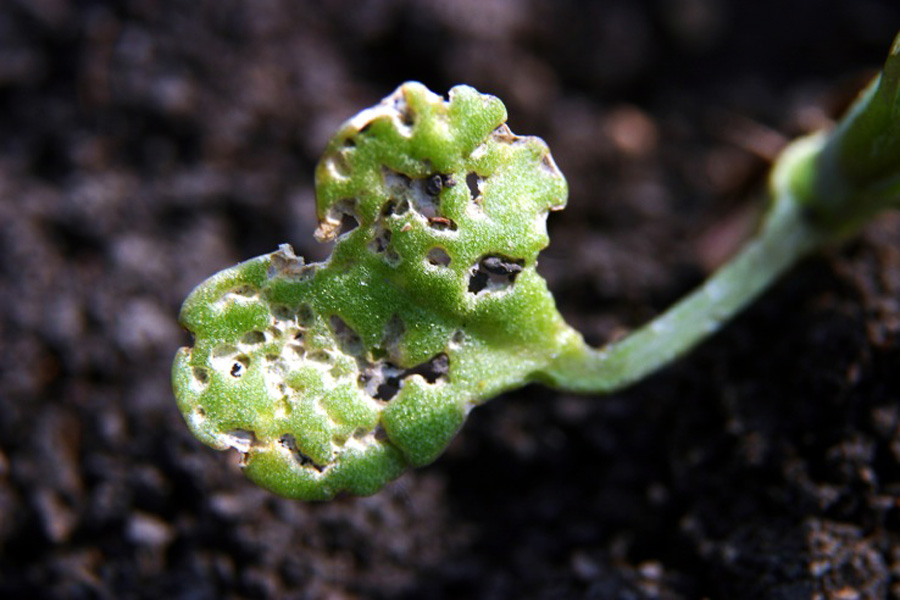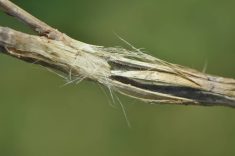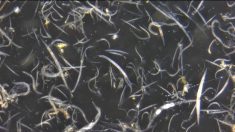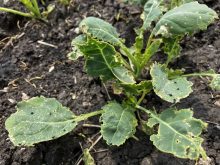Flea beetles are munching on Manitoba canola crops but a provincial entomologist says the damage may look worse than it is.
If there’s more than 25 per cent feeding damage after the canola crop has been planted for at least three weeks, an insecticide application could be economic, John Gavloski said in a Manitoba Agriculture, Food and Rural Development webinar June 5. However, estimating damage is difficult, because flea beetles have to eat some of the canola before being killed by the seed treatment.
And once canola reaches the three- to four-leaf stage it can usually tolerate flea beetle feeding, Gavloski added.
Read Also

Manitoba sclerotinia picture mixed for 2025
Variations in weather and crop development in this year’s Manitoba canola fields make blanket sclerotinia outlooks hard to pin down
Studies that looked at the relationship between seeding dates and flea beetle damage have showed varying results.
“My gut feeling is this year, the later seeding might help in the sense that one of the keys to reducing flea beetle feeding is getting the plants from seeding to that three- to four-leaf stage quickly.”
Seed treatments are believed to provide about three weeks of flea beetle protection.
Flea beetle damage is often worse during cold springs when canola plants aren’t growing.
“So some of the later-seeded fields might not do too bad in the sense that when they do come up hopefully within three weeks, while the seed treatment is still quite active, they can get some true leaves and get through to the more resistant stages.”
Some farmers had started spraying flea beetles last week.
“Last year some people did multiple sprays,” Gavloski said. “I’m hoping… now that we’ve got some good moisture and warm weather, the plants should get to those resistant stages quickly and we can avoid some of that.”
There are more than 70 different flea beetle species in Manitoba, but striped and crucifer cause most of the damage to canola, Gavloski said.
- Check out Crop Chatter: Manitoba insect and disease update
Cutworms
There have been isolated pockets of cutworms in the eastern and central regions, which during the larval stage cuts off newly emerging crops, Gavloski said.
“So far most of what I am aware of is in corn and sunflowers, but I know there have been some wheat fields with higher cutworm levels.”
The dingy cutworm is showing up the most, but the redbacked cutworm is also common in Manitoba.
“Based on the size that I’ve seen they (dingy) will be feeding for at least another week, perhaps two weeks so keep an eye on your fields,” he said. “Redbacked cutworms could be feeding right to the end of June.”
Look for feeding damage or slipped plants, Gavloski said. Where you find a lot of that dig just under the soil near damaged plants to see if there are cutworms there.
Cutworms will be close to the soil surface in moist soils and deeper in drier soils.
If a heavy cutworm population warrants a foliar insecticide application, do so as late in the day as possible since cutworms are nocturnal, Gavloski said.
Cutworm damage is typically patchy so often farmers can just spray those patches.
The University of Manitoba is collecting cutworms for a study into cutworm parasites. Researchers hope to be able to reduce cutworm populations using those parasites.
Farmers with cutworms can contact Gavloski by phone at 204-745-5668 or by emailing [email protected] and he’ll forward the information to the researchers.
Wireworms
Wireworms, which feed on plant roots, are also a concern as seed treatments only repel them, and foliar insecticides don’t control them, Gavloski said.
There have been few wireworm reports this season, Gavloski said.
Not all seed treatments work equally in repelling all wireworm species. Researchers are doing a wireworm survey to learn more.
Diamondback moths are showing up in traps at Morris and east of Lake Winnipeg. Where trap numbers are high, farmers should be scouting later for diamondback moth larvae. However, high moth counts don’t necessarily translate into high numbers of larvae, Gavloski said.
Grasshoppers are also emerging too. Check ditches and field edges. If numbers warrant, control them with insecticides.
Grasshoppers are easier to kill when they’re small and before they move into fields.
Make sure that it’s grasshoppers you’re seeing and not leafhoppers, which are mostly beneficial, Gavloski stressed.
The insecticide Coragen is now registered for use against grasshoppers in cereals and forages, he said.




















